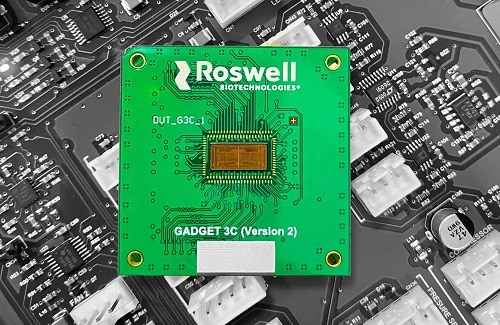The new molecular electronics platform detects multi-omic molecular interactions at the single-molecule scale, in real-time

The molecular electronics platform consists of a programmable semiconductor chip with a scalable sensor array architecture. Each array element consists of an electrical current meter that monitors the current flowing through a precision-engineered molecular wire, assembled to span nanoelectrodes that couple it directly into the circuit.
[sociallocker id=”97245″]
The sensor is programmed by attaching the desired probe molecule to the molecular wire, via a central, engineered conjugation site. The observed current provides a direct, real-time electronic readout of molecular interactions of the probe. These picoamp-scale current-versus-time measurements are read out from the sensor array in digital form, at a rate of 1000 frames per second, to capture molecular interactions data with high resolution, precision and throughput.
“The goal of this work is to put biosensing on an ideal technology foundation for the future of precision medicine and personal wellness,” added Roswell co-Founder and Chief Scientific Officer Barry Merriman, PhD. “This requires not only putting biosensing on the chip, but in the right way, with the right kind of sensor. We’ve pre-shrunk the sensor element to the molecular level to create a biosensor platform that combines an entirely new kind of real-time, single-molecule measurement with a long-term, unlimited scaling roadmap for smaller, faster and cheaper tests and instruments.”
The new molecular electronics platform detects multi-omic molecular interactions at the single-molecule scale, in real-time. It presents a wide array of probe molecules, including DNA, aptamers, antibodies, and antigens, as well as the activity of enzymes relevant to diagnostics and sequencing, including a CRISPR Cas enzyme binding its target DNA. It illustrates a wide range of applications for such probes, including the potential for rapid COVID testing, drug discovery and proteomics.
The molecular electronics sensor is also capable of reading DNA sequences. In this sensor, a DNA polymerase, the enzyme that copies DNA, is integrated into the circuit, and the result is a direct electrical observation of the action of this enzyme as it copies a piece
of DNA, letter-by-letter.
Unlike other sequencing technologies that rely on indirect measures of polymerase activity, this approach achieves direct, real-time observation of a DNA polymerase enzyme incorporating nucleotides. These activity signals can be analysed with machine learning algorithms to allow the reading of the sequence.
“The Roswell sequencing sensor provides a new, direct view of polymerase activity, with the potential to advance sequencing technology by additional orders of magnitude in speed and cost,” said Professor George Church, member of the National Academy of Sciences, and a Roswell Scientific Advisory Board member. “This ultra-scalable chip opens up the possibility for highly distributed sequencing for personal health or environmental monitoring, and for future ultra-high-throughput applications such as Exabyte-scale DNA data storage.”
[/sociallocker]







